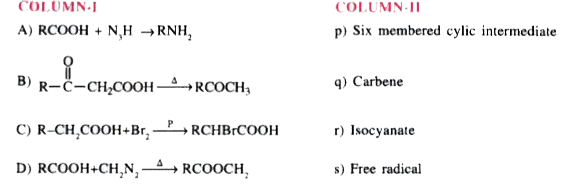How many of the following compounds can give 3∘-Alcohols with excess of CH3MgCl and followed by Hydrolysis
 Solution in Telugu
Solution in Telugu
The correct Answer is:6
Related Playlists
- BOOK - AAKASH SERIESCHAPTER - CARBOXYLIC ACIDS EXERCISE - PRACTICE SHEET-4 (Matching Type Questions)2videos
CARBOXYLIC ACIDS
- BOOK - AAKASH SERIESCHAPTER - CARBOHYDRATESEXERCISE - Practice Sheet-530videos
CARBOHYDRATES
- BOOK - AAKASH SERIESCHAPTER - CARBOXYLIC ACIDS AND DERIVATIVESEXERCISE - CONVERSIONS19videos
CARBOXYLIC ACIDS AND DERIVATIVES
Similar Questions
Matching Type Questions
 02:29View Solution
02:29View SolutionD-tagatose is a 2-ketohexose which forms same osazone as D-galactose. What is the structure of D-tagatose
View SolutionMethanol to acetic acid
View SolutionThe reaction of ethyl formate with excess of CH_(3)MgI followed by hydrolysis gives
02:51View SolutionWhich of the following would give tertiary alcohol when it reacts with an excess of CH_(3)MgBr followed by hydrolysis
View SolutionWhich of the following compound would give secondary alcohol when reacts with an excess of phenyl magnisium bromide followed by hydrolysis.
View SolutionWhich of the following compounds reaction with excess CH3MgBr and subsequent hydrolysis will give a tertiary alcohol ?
View SolutionReaction of ethyl acetate with excess of CH_(3)MgI followed by hydrolysis gives :
03:29View SolutionReaction of ethyl formate with excess of CH3MgI followed by hydrolysis gives
01:06View SolutionThe following compound on hydrolysis will give
 View Solution
View SolutionThe adduct of the compound 'A' obtained by the reaction with excess of isopropyl magnesium iodide , upon hydrolysis gives a tertiary alcohol. The compound 'A' is
08:24View SolutionRMgBr on reaction with an excess of oxygen followed by hydrolysis gives
View SolutionOf the following amines how many can give foul smell with CHCl_(3) and alcoholic KOH :
View SolutionThe adduct of a compound (A) with isopropyl magnesium halide on hydrolysis gives a tertiary alcohol. The compound (A) is:
03:24View SolutionReaction of ethyl formate with excess of CH3Mgl followed by hydrolysis gives .
06:13View Solution



